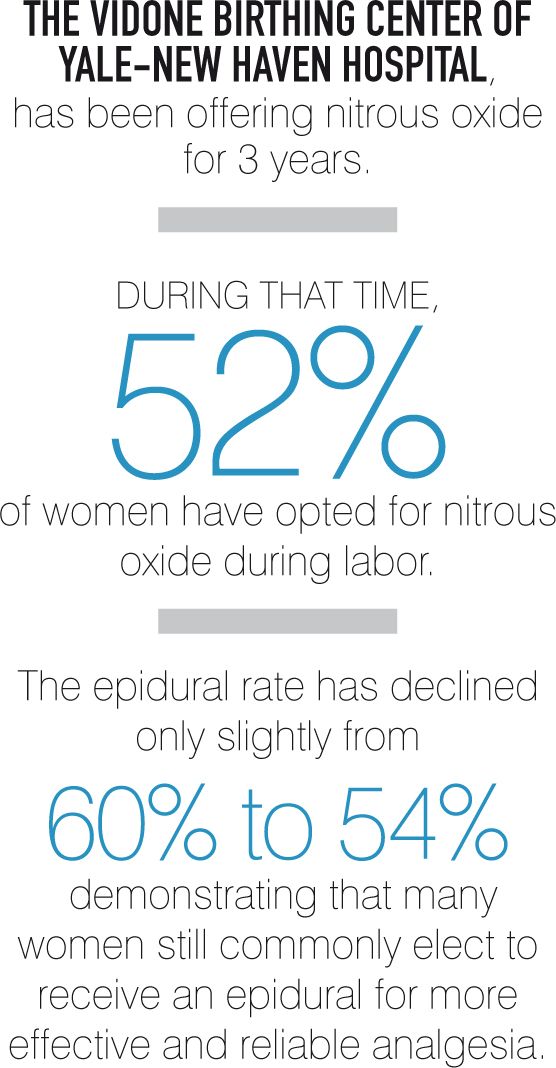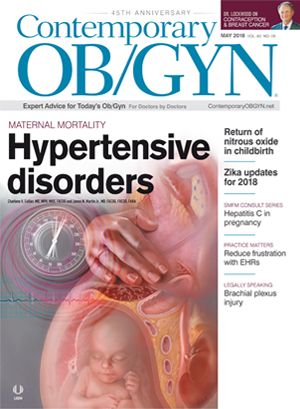Nitrous oxide’s revival in childbirth
Jessica L. Illuzzi, MD, MS

Michelle L. Telfer, CNM, DNP, MPH

Phil Rubin, MD

Across the United States, nitrous oxide (N2O) is attracting attention as a desired option for analgesia during childbirth. Worldwide it remains one of the most common labor analgesics, utilized widely in many countries in Europe (up to 75% of women in the UK), the Middle East, Asia, and Australia1. In the United States, nitrous oxide was commonly used during labor from the 1930s to the 1950s, often given with other potent agents, such as scopolamine, ketamine, or narcotics. It remains in frequent use today for outpatient pediatric dentistry.
In the 1970s, nitrous oxide use in childbirth declined with the increasing availability of epidural analgesia. Many hospitals in the United States no longer installed nitrous oxide gas lines in labor and delivery rooms, and the next generation of American obstetricians, anesthesiologists, and parturients became unfamiliar with its use in labor. Not until consumers and the midwifery community began seeking its use did nitrous oxide begin to re-emerge.2 The US Food and Drug Administration’s (FDA) approval of a portable nitrous oxide delivery system in 2012 further facilitated its re-emergence in this country. New protocols have developed via coordinated team efforts among obstetricians, midwives, nurses, and anesthetists. Today, dozens of hospitals and birth centers in the United States are offering nitrous oxide once again for pain management during labor. Interest in its use is accelerating for those parturients desiring low-intervention births. Centers are increasingly offering such services, as they aim to meet consumer needs and increase patient satisfaction.
Physiology and pharmacology
Nitrous oxide is a colorless, non-flammable, sweet-smelling gas with both anesthetic and analgesic properties when inhaled. Its analgesic and anxiolytic mechanisms of action include inhibition of N-methyl-D-aspartate (NMDA) antagonism, modulation of γ-aminobutyric acid (GABA) nerve pathways and glycine potentiation.3 Along with these effects, increases in dopamine, norepinephrine, and endogenous opioid release decrease pain perception, producing a sense of euphoria and sometimes psychedelic effects.
For labor-related analgesia, women inhale nitrous oxide just prior to the start of and throughout each contraction. Due to low solubility of the gas, there is rapid uptake within 3 to 4 breaths with maximum analgesic effect in 40 to 60 seconds. Following a contraction, there is rapid maternal clearance with cessation of nitrous oxide inhalation. Women remain alert, maintaining motor and sensory function, including a strong laryngeal reflex that helps to prevent aspiration. Intake is self-administered and self-regulated; if the patient becomes too drowsy, she will not be able to hold her mask in place, and the gas will rapidly clear within a few breaths.4
Importantly, the FDA-approved portable nitrous oxide delivery systems for childbirth have safety features that limit gas concentration to a 50/50 mixture with oxygen. Demand valves permit nitrous oxide flow only when the patient establishes a good seal with the mask and engages in purposeful inspiration. In addition, these units are connected to scavenging systems to remove exhaled gas.
Maternal and fetal effects
A Cochrane review of 26 studies with randomization of a total of 2959 women to nitrous oxide found a decreased perception of pain intensity (RR 0.06, 95% CI 0.01-0.34), compared to placebo, decreased maternal anxiety, and increased satisfaction and sense of control.5 A more recent systematic review evaluated a total of 58 studies.6 The authors rated only 2 of these studies as good quality, 11 as fair quality, and 46 as poor quality, and concluded that, “further research is needed across all of the areas examined: effectiveness, satisfaction, and adverse effects.” One study of 2482 women found that 38% to 42% rated nitrous oxide as very effective pain management compared to 72% to 84% of those who received an epidural.7 In another study, only 35% of women receiving nitrous oxide and meperidine were satisfied with their pain management compared to 69% of women receiving an epidural.8 These findings underscore that nitrous oxide is not as effective as the US “gold standard” epidural analgesia. While not effective for some, patients may find the gas a useful alternative to other modalities or a strategy that represents minimal intervention.
Side effects of nitrous oxide during labor documented in 1000 women in Australia included nausea (13%) as the most common, followed by dizziness (5%) and drowsiness (4%). Eighteen percent of the patients reported reduced awareness, which may contribute to nitrous oxide’s effect on mediating pain.9
Other studies have examined the effects of nitrous oxide on the fetus and neonate. Nitrous oxide crosses the placenta, achieving approximately 0.8 of the maternal level during peak use. It is also quickly eliminated by diffusion across the placenta and neonatal respiration at birth. 4 In contrast to in utero fetal exposure to narcotics, there is no evidence of central nervous system or respiratory depression, or increased admission to intensive care among neonates exposed to nitrous oxide in utero.8,10 There is no effect on cord blood gases,11 Apgar scores,8 or neonatal behavior.12 In addition, there are no documented effects on fetal heart rate (FHR) patterns, labor progress,4 or incidence of meconium-stained amniotic fluid.11
These findings are mitigated by the lack of extensive long-term studies on infants and children exposed to nitrous oxide during labor. However, long-term data are also lacking for other intrapartum medication exposures (e.g., narcotics, antibiotics, anesthetics, and uterotonics). While it is reassuring that widespread and historic use of nitrous oxide during labor has not been linked to specific long-term problems, the lack of data remains an important caveat to use of nitrous oxide. For example, in a 1991 case-control study of childhood leukemia, a trend toward higher odds of having been exposed in utero to nitrous oxide was observed among boys (OR = 1.4; 95% CI = 1.0, 1.9) but not girls (OR = 1.1; 95% CI = 0.8, 1.6), and this effect was noted in the cohorts born in 1973 and 1974 but not in later birth cohorts (1975-1984).13 The same study identified exposure to oxygen supplementation and hyperbilirubinemia as possible risk factors for childhood leukemia. Thus it is important that providers inform their patients interested in nitrous oxide during labor about its theoretical, but likely low risks to the newborn.
Contraindications
Though most parturients can opt for nitrous oxide, there are various contraindications to its use in labor. Because it must be self-administered, parturients who cannot hold their own masks, have impaired consciousness, or are intoxicated are not eligible for the gas. Similarly, patients receiving magnesium sulfate, intravenous narcotics, or other agents that may cause respiratory suppression may not be candidates. Relative contraindications include sleep apnea with or without constant positive airway pressure use or conditions that impair oxygenation. Less common contraindications include recent intraocular or middle ear surgery, bowel obstruction, known increased intracranial pressure, and pulmonary hypertension. Patients with a Category III FHR tracing or those with a Category II FHR tracing requiring resuscitative measures are also not considered good candidates for nitrous oxide.
In addition, in the presence of vitamin B12 deficiency nitrous oxide inhibits methionine synthase, an enzyme involved in the synthesis of DNA, RNA, myelin, and catecholamines. Therefore, vitamin B12 deficiency may also be a contraindication to use of the gas. This may involve patients who have had gastric bypass surgery or bowel resection, those with Crohn’s disease, hereditary B12 deficiency, or pernicious anemia, or who have chronic malnutrition or on vegan diets. Vitamin B12 levels in such patients can be evaluated during pregnancy and often replenished to normal levels that are considered safe for nitrous oxide use in labor.14
Typical protocols
When considering introduction of nitrous oxide to a labor unit, it is vital to develop policies and protocols for its use, as well as programs to educate providers and staff. A standard protocol would include screening for contraindications, informing patients of risks and benefits, and educating on effective use of the gas. Providers must stress that the gas needs to be self-administered and used only by the parturient. Once the delivery system is set up and nitrous oxide is initiated, vital signs are monitored in standard intervals, and some hospitals also monitor oxygen saturation for a brief period of time upon initiating. The patient is monitored for safety and effectiveness of treatment, and the fetus is monitored in a standard fashion by intermittent auscultation or continuous FHR monitoring as appropriate. Patients should be coached to start inhaling the nitrous mixture at least 30 seconds before a contraction so that therapeutic levels are achieved at the peak of the contraction. Patients who do not experience the desired effects or who develop intolerable effects can discontinue use at any time, which should result in prompt resolution of the symptoms due to rapid elimination of the gas.
Nitrous oxide can be used during all stages of labor. It has also been found to be helpful during laceration repair, vigorous fundal massage, manual extraction of the placenta, challenging intravenous access, epidural placement, and difficult vaginal exams. In partnership with the anesthesia team, it may also serve as a useful adjunct to epidural analgesia when there is a sensory window or significant maternal anxiety. Some institutions have also begun offering it during external cephalic version.
When offering nitrous oxide, it is necessary to have a functioning scavenging system in place to suction exhaled nitrous oxide, adequate room ventilation, and equipment that can alarm for nitrous oxide leaks. The current FDA-approved nitrous oxide scavenging systems yield environmentally safe nitrous oxide levels below the OSHA limit of 25 ppm in well-ventilated rooms.15 Levels above 500 to 1000 ppm have been associated with cell toxicity in animal studies and decreased fecundity in women working in dental offices without scavenging or adequate ventilation.16 Some hospitals perform regular monitoring in rooms where nitrous oxide is used, and others require staff to wear personal dosimetry badges.
Our experience

At the Vidone Birthing Center of Yale-New Haven Hospital (YNHH), we have been offering nitrous oxide for 3 years. During that time, 52% of women have opted for nitrous oxide during labor. The epidural rate has declined only slightly from 60% to 54% in our midwifery-based center, demonstrating that many women still commonly elect to receive an epidural for more effective and reliable analgesia. These numbers may also be confounded by the fact that nitrous oxide cannot be used as the sole anesthetic for cesarean delivery. We have observed, though, that epidurals are typically requested later in the course of labor, there is decreased utilization of narcotics, and that women remain more active during the early phase of labor, taking advantage of alternative therapies including hydrotherapy and water immersion.
In an era in which many women are seeking less intervention and more personal control over their birth experience, nitrous oxide is re-emerging as a useful pain management modality. Laboring patients who use nitrous oxide do not require intravenous fluid, continuous FHR monitoring, or bladder catheterization. While ambulation is not recommended during use of the gas, patients can sit in a chair, on a birthing ball or in various positions in bed. If they want to stand up, walk, or use the bathroom, they can simply stop using nitrous oxide and wait a few minutes before ambulating. In addition, they can easily move from the gas to other alternatives, including water immersion, hydrotherapy, narcotics or epidural analgesia. At YNHH, the increased mobility and active participation of parturients with nitrous oxide use was an unanticipated outcome. Women who had received early narcotics or an epidural, on the other hand, often became bed-bound, remaining there until delivery. More women have remained mobile throughout their labors and often switch from one modality to another, often going back to nitrous oxide at a later point in their labors. Nitrous oxide also has been particularly helpful for sensory windows, maternal anxiety, and during difficult vaginal exams and repairs.
Use of nitrous oxide in hospitals and birthing centers in the United States is expanding, which requires collaboration with anesthesiologists in writing protocols and educating providers and staff. In some centers, the anesthesia service screens for eligibility and orders nitrous oxide for laboring patients, while in others, obstetric or midwifery providers independently manage this therapy. In most settings, nurses set up and monitor use of nitrous oxide during labor. As of this writing, there are currently no specific billing codes (DRG or CPT) for obstetric nitrous oxide use in labor, so many hospitals are providing this service inclusive in the global reimbursement. A working group has been working to address the deficiency in billing codes to allow for reimbursement for these particular services. Nitrous oxide itself is inexpensive, so the largest initial investment is for the portable equipment.
Conclusion
Nitrous oxide remains a popular modality for pain management for women around the globe. It can be used exclusively, or as an adjunct to other methods. Contraindications, side effects, and complication rates are low. Nitrous oxide may increase patient satisfaction by giving women a greater sense of control during labor in an era when more women are seeking this type of birthing experience.
Disclosures:
The authors report no potential conflicts of interest with regard to this article.
References:
- Rooks JP. Nitrous oxide for pain in labor - Why not in the United States? Birth. 2007;34(1):3-5..
- American College of Nurse-Midwives. Position Statement: Nitrous Oxide for Labor Analgesia. 2011:1-5.
- Emmanouil DE, Quock RM. “Advances in Understanding the Actions of Nitrous Oxide.” Anesthesia Progress. 54.1 (2007): 9–18. PMC. Web. 15 Jan. 2018.
- Rosen MA. Nitrous oxide for relief of labor pain: a systematic review. Am J Obstet Gynecol. 2002;186(5 Suppl Nature):S110-S126.
- Klomp T, van Poppel M, Jones L, Lazet J, Di Nisio M, Lagro-Janssen ALM. Inhaled analgesia for pain management in labour. Cochrane database Syst Rev. 2012;(9):CD009351.
- Likis FE, Andrews JC, Collins MR, et al. Nitrous oxide for the management of labor pain: A systematic review. Anesth Analg. 2014;118(1):153-167.
- Waldenstrom U, Irestedt L. Obstetric pain relief and its association with remembrance of labor pain at two months and one year after birth. J Psychosom Obstet Gynaecol. 2006;27(3):147-156.
- Leong EW, Sivanesaratnam V, Oh LL, Chan YK. Epidural analgesia in primigravidae in spontaneous labour at term: a prospective study. J Obstet Gynaecol Res. 2000;26(4):271-275.
- Paech MJ. The King Edward Memorial Hospital 1,000 mother survey of methods of pain relief in labour. Anaesth Intensive Care. 1991;19(3):393-399.
- Bricker L, Lavender T. Parenteral opioids for labor pain relief: A systematic review. Am J Obstet Gynecol. 2002;186(5 SUPPL.):94-109.
- Su F, Wei X, Chen X, Hu Z, Xu H. [Clinical study on efficacy and safety of labor analgesia with inhalation of nitrous oxide in oxygen]. Zhonghua Fu Chan Ke Za Zhi. 2002;37(10):584-587.
- Harrison RF, Cullen R. A comparative study of the behaviour of the neonate following various forms of maternal intrapartum analgesia and anaesthesia. Ir J Med Sci. 1986;155(1):12-18.
- Zack M, Adami H-O, Ericson A. Maternal and Perinatal Risk Factors for Childhood Leukemia. Cancer Res. 1991;51(14):3696-3701.
- Rooks JP. Safety and risks of nitrous oxide labor analgesia: a review. J Midwifery Womens Health. 2011;56(6):557-565.
- Westberg H, Egelrud L, Ohlson CG, Hygerth M, Lundholm C. Exposure to nitrous oxide in delivery suites at six Swedish hospitals. Int Arch Occup Environ Health. 2008;81(7):829-836.
- Rowland ASAS. Reduced fertility among women employed as dental assistants exposed to high levels of nitrous oxide. N Engl J Med. 1992;327(14):993-997.
S1E4: Dr. Kristina Adams-Waldorf: Pandemics, pathogens and perseverance
July 16th 2020This episode of Pap Talk by Contemporary OB/GYN features an interview with Dr. Kristina Adams-Waldorf, Professor in the Department of Obstetrics and Gynecology and Adjunct Professor in Global Health at the University of Washington (UW) School of Medicine in Seattle.
Listen
Study shows a healthy prenatal diet could be upstream obesity prevention strategy
December 26th 2024"Our findings support the recommendation of a healthy diet based on the current guidelines (as measured by the HEI) during pregnancy, since it may reduce patterns of infant growth outside reference ranges."
Read More
Early pregnancy cannabis use high in states with recreational legalization
November 11th 2024A population-based time-series analysis California before, during and after legalization show a rising trend in women using cannabis while pregnancy especially when the state has legalized the drug.
Read More

